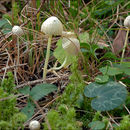Associations
provided by BioImages, the virtual fieldguide, UK
Foodplant / saprobe
fruitbody of Mycena epipterygia is saprobic on dead, decayed debris of Pteridium aquilinum
Plant / associate
fruitbody of Mycena epipterygia is associated with Poaceae
Foodplant / saprobe
fruitbody of Mycena epipterygia is saprobic on dead, decayed, fallen woody of debris of Broadleaved trees
Foodplant / saprobe
fruitbody of Mycena epipterygia is saprobic on dead, decayed, fallen woody of debris of Pinopsida
Characteristic features of mycena epipterygia (pictures and text)
provided by EOL authors
Guidance for identification (German text)
Comprehensive Description
provided by North American Flora
Prunulus epipterygius (Scop.) Murrill
Agaricus epipterygius Scop. Fl. Cam. ed. 2. 2: 455. 1772. Mycena epipterygia Qu^l. Champ. Jura Vosg. 73. 1872.
Pileus membranous, campanulate to expanded, subobtuse, solitary or cespitose, 1-3 cm. broad; surface variable, cinereous or rufescent, the pellicle viscid, margin striate: lamellae adnate with a decurrent tooth, thin, versicolored, whitish, cinereous, bluish-gray, etc.: spores ellipsoid, 8-10 X 4—5 ju: stipe elongate, tough, radicate, viscid, glabrous, fibrillose at the base, yellowish or cinereous, fistulose, 5-11 cm. long, 2-3 mm. thick.
Type I.OCALITY: Carniola, Austria. Habitat: On moss on logs.
Distribution: Eastern temperate North America; also in Europe.
- bibliographic citation
- William Alphonso MurrilI, Gertrude Simmons BurIingham, Leigh H Pennington, John Hendly Barnhart. 1907-1916. (AGARICALES); POLYPORACEAE-AGARICACEAE. North American flora. vol 9. New York Botanical Garden, New York, NY
Comprehensive Description
provided by North American Flora
Prunulus splendidipes (Peck) Murrill
Mycena splendidipes Peck, Bull. N. Y. State Mus. 167: 28. 1913.
Pileus thin, sub membranous, ovoid when young, subcampanulate or convex with age, 10-20 mm. broad; surface glabrous, striate, viscid, brown at the center and yellow near the margin when young, becoming grayishgreen, greenish-brown, or brown with age; margin persistently appressed and constricted, palUd: context having a strong odor and disagreeable taste, poisonous; lamellae subdistant, rather narrow, adnate, white or whitish: spores broadly ellipsoid or subglobose, 6-8 X 4-6 ^i stipe long or short, straight or flexuous, hollow, glabrous, viscid, bright-lemon-yellow, 5-30 cm. long, 2-4 mm. thick.
Type LOCaIvITy: Richmond County, New York. Habitat: On decaying pine leaves. Distribution: Known only from the type locality.
- bibliographic citation
- William Alphonso MurrilI, Gertrude Simmons BurIingham, Leigh H Pennington, John Hendly Barnhart. 1907-1916. (AGARICALES); POLYPORACEAE-AGARICACEAE. North American flora. vol 9. New York Botanical Garden, New York, NY
Mycena epipterygia
provided by wikipedia EN
Mycena epipterygia is a species of fungi in the family Mycenaceae of mushrooms commonly found in Europe.[1] It is commonly known as yellowleg bonnet.[2] The species is saprotrophic and its appearance is quite variable. For example, a number of members of the genus Mycena, some parts of the fungus are bioluminescent, including in this species, the mycelium.[3] Mycena nivicola has been suggested as a separate species name for the Western variety.[4]
Distribution and habitat
M. epipterygia is a common species in Western Europe (amongst others Netherlands and Belgium). It grows in diverse habitats: in deciduous and coniferous woods, but it is also found in heather and acid grasslands, amongst grasses and mosses. This species grows on the ground. In Britain, the fruiting bodies appear from August to November.[2] In the North American Pacific Northwest, the species appears in groups, in needle litter and on wood.[4]
Description
The cap is striate, bell-shaped at first, but becoming convex, or occasionally nearly flat with the margin turning up slightly. The cap has a sticky surface from which the cuticle can be peeled,[1] and measures 1 to 2 cm (3⁄8 to 3⁄4 in) wide, with a colour varying from yellowish brown to gray-brown.[4] The margin is somewhat irregular, and the flesh white and fragile. The stipe is long and slender, about 4–9 cm (1+5⁄8–3+1⁄2 in) tall and 1–2 mm wide;[5] it does not taper, and is yellowish to yellow-green, the colour serving to distinguish the fungus from other species.[2]
The gills are white to cream, sometimes tinged with pink when older; they are fairly widely spaced, adnate, or slightly decurrent. The spores are amyloidic and have a length of 8 to 10 micrometres and a width of 4 to 5.5 micrometres. The spore print is white to very pale buff.[2]
Edibility
The species is considered edible, but is of little interest in the kitchen.[6]
Similar species
The species resembles Mycena aurantiidisca, M. clavicularis, M. leptocephala, and Roridomyces roridus.[5]
See also
References
-
^ a b Gerhardt, Ewald (2006). De grote paddenstoelengids voor onderweg, Tirion uitgevers B.V., Baarn, ISBN 90-5210-653-3
-
^ a b c d "Mycena epipterygia (Scop.) Gray - Yellowleg Bonnet". First Nature. Retrieved 15 January 2021.
-
^ Perry, Brian (2007). "Bioluminescent fungi". MycoWeb. Retrieved 15 January 2021.
-
^ a b c Trudell, Steve; Ammirati, Joe (2009). Mushrooms of the Pacific Northwest. Timber Press Field Guides. Portland, OR: Timber Press. pp. 125–126. ISBN 978-0-88192-935-5.
-
^ a b Davis, R. Michael; Sommer, Robert; Menge, John A. (2012). Field Guide to Mushrooms of Western North America. Berkeley: University of California Press. pp. 175–176. ISBN 978-0-520-95360-4. OCLC 797915861.
-
^ Phillips, Roger (2010) [2005]. Mushrooms and Other Fungi of North America. Buffalo, NY: Firefly Books. p. 99. ISBN 978-1-55407-651-2.

- license
- cc-by-sa-3.0
- copyright
- Wikipedia authors and editors
Mycena epipterygia: Brief Summary
provided by wikipedia EN
Mycena epipterygia is a species of fungi in the family Mycenaceae of mushrooms commonly found in Europe. It is commonly known as yellowleg bonnet. The species is saprotrophic and its appearance is quite variable. For example, a number of members of the genus Mycena, some parts of the fungus are bioluminescent, including in this species, the mycelium. Mycena nivicola has been suggested as a separate species name for the Western variety.
- license
- cc-by-sa-3.0
- copyright
- Wikipedia authors and editors

